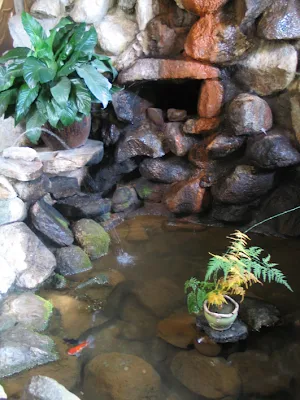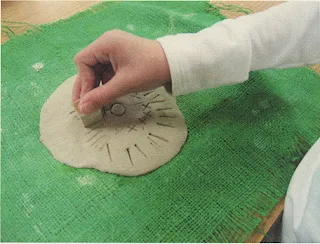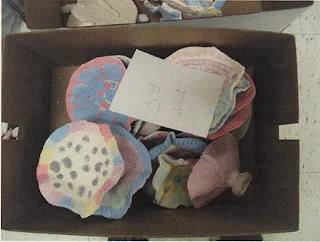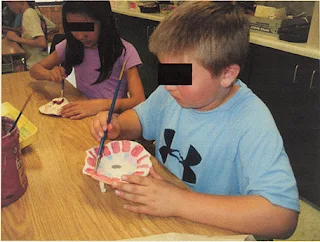 |
| Above student cardboard prints |
Title: Cardboard Printing
Goals and Objectives:
- Students will design a simple shape influenced by nature.
- Students will make prints from a shallow, two dimensional surface using a brayer and printer’s ink.
Integration: Art & Science
GLEs:
Strand I: Product/Performance for Other Media
D.1. Select and apply two-dimensional media, techniques, and processes to communicate ideas and solve challenging visual art problems.
Grade 3 - Demonstrate an additive process (e.g., string, cardboard, glue, found objects)
Strand I: Product/Performance for Subject Matter: Fine Art
A.3. Communicate ideas about subject matter and themes in artworks created for various purposes
Grade 3 – Figure: Create an original artwork of a figure in an action pose, Landscape: Create an original cityscape, Non-Objective: Create an original artwork using line, shape and color
Strand I: Product/Performance for Theme
C.3. Communicate ideas about subject matter and themes in artworks created for various purposes.
Grade 3 - Create an original artwork that communicates ideas about the following themes:
· Community
· Group identity (e.g., family, classroom, groups, scouts, sports teams)
Grade 4 - Create an original artwork that communicates ideas about the following themes:
· Missouri
· The Environment
· Time (e.g., past, present, future)
Strand II: Elements and Principles – Shapes
B. 1. Select and use elements of art for their effect in communicating ideas through artwork.
Grade 3 - Differentiate between shapes and forms
Grade 4 - Identify and use organic (freeform) shapes
Strand IV: Interdisciplinary Connections That Connect Art and Non-Art Subjects
A.2. Explain the connections between Visual Arts and Communication Arts, Math, Science, or Social Studies.
Insect Life, defense, habitats etc...
Grade: 3rd and 4th
Length of Class Period: 55 min.
Frequency of Class Period: once a week
Time Needed: two class periods
Facility & Equipment Requirements:
- One computer lap top
- Room with good lighting
- Large tables, approximately ten, each seating four students
- Two sinks
- Dry erase board
- Drying racks
- Cabinets for storage
- Projector for viewing computer video, CDs and DVDs
Resources Needed:
- Power Point about print making
- “Just Kiddin’ Around” video by the Missouri Department of Conservation (JKA #02 Insects)
Materials Per Student:
- newsprint
- Two 4”x4” cardboard pieces
- ink selections
- brayer
- white glue
- white paper for printing on
- printer's ink
- sheet of glass or acrylic for spreading paint with brayer evenly (old cookie sheets may be used if glass sheets are unavailable.)
Vocabulary/Terminology:
- print - to take impressions from a type such as: cardboard, stamp, linoleum carving, sand print etc...
- mirror image - an image of an object, plan, person, etc., as it would appear if viewed in a mirror, with right and left reversed.
- brayer - a small roller for inking type by hand, usually for making a proof.
- symmetrical - regular in form or arrangement of corresponding parts that demonstrate balance
- asymmetrical - an irregular form or arrangement of parts that demonstrate balance
Motivation - Looking and Talking Activity: Large group discussion about “Just Kiddin’ Around” video by the Missouri Department of Conservation (JKA #02 Insects)
Step-by-Step Studio Activity Specifics:
- Students will watch brief video selection from Missouri Department of Conservation about insects.
- Students will discuss the video in a large, classroom discussion
- Students will practice drawing insects on newsprint and then draw a final insect on their cardstock
- Students will cut out their insect or nature design
- Students will then glue their cut designs to the second 4”x4” piece of cardboard
- The teacher will demonstrate for the students how to use a brayer with printer's ink and then print a sample in front of the students
- The teacher will provide for each table printer's ink spread evenly on a sheet of glass
- Students will print from their own sample several color versions of their nature/insect design. Students will need to wait for their cardboard print to dry slightly between printings in order to make two distinct color versions.
Health & Safety Concerns: There are no health and safety concerns for this project.
Special Needs Adaptations:
Modifications for the hard-of-hearing or deaf student:
- Student will be seated closer to instructor so they will be better equipped to hear instructions or read lips
- Student will be provided with written instructions so that they read about the discussions and demonstrations
- The instructor may use a amplification devise provided by the school or student’s parents
Modifications for the student with limited vision or blindness:
- Students will be allowed to observe samples of art projects with their hands and for extended periods of time
- Students will be provided with safe tools and one-on-one guidance during a demonstration of the project
- The project may be slightly adjusted to accommodate the student’s limitations or for safety reasons
- Student will be given ample time to exist classroom before large crowds gather outside of the classroom.
Modifications for students with mild brain injury:
- Students will be provided with duplicate instructions for home and school. Student will not need to remember to carry home materials to review.
- Students will be given ample time to exist classroom with a pre-determined aid or peer before the official end of a class.
- Instructor will provide for parent e-mail communication concerning the progress and needs of their student.
- Student may be given special seat assignment in order to enable his participation in class appropriately. Specific peers may be better equipped to articulate projects visually for this student.
Cleanup Time & Strategy: Students will be instructed to put away art materials neatly in their containers, clean off their tables, and recycle their trash two minutes prior to dismissal. Teachers should rinse off the brayers and glass sheets.
Assessment: Fill out the formal scoring guide developed by the your school district according to age appropriate standards.
copyrighted 2011 Grimm
Need more printing ideas:






























